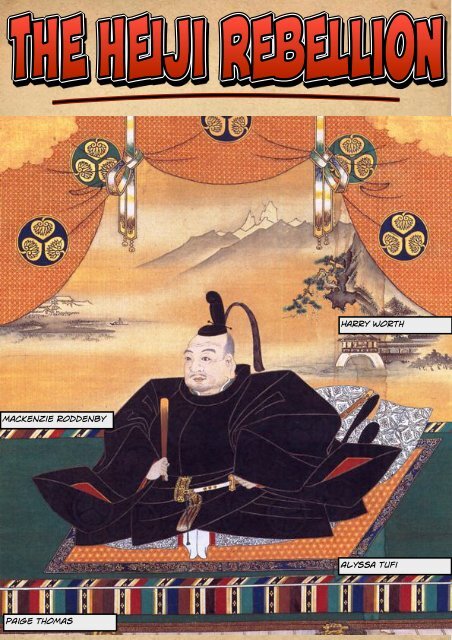Create successful ePaper yourself
Turn your PDF publications into a flip-book with our unique Google optimized e-Paper software.
Harry worth<br />
Mackenzie roddenby<br />
Alyssa Tufi<br />
PAige thomas
During the Heian Period in early japan each samurai<br />
clan build up strength and finally seized of the<br />
whole eastern side of japan.<br />
After building up their armies they then move<br />
out into the open just outside a peasants<br />
village getting ready to fight one the dame’s<br />
land with cuirass armour for the upper body,<br />
wakizushi, katana and husanagi.<br />
Your words here...<br />
After fighting for a couple of days they then<br />
move closer towards the village of peasants..
Destroying each and every<br />
single use, they destroy the<br />
village. After destroying<br />
the village they then move<br />
towards the emperors<br />
palace.<br />
we are<br />
here<br />
Attack!<br />
Soon enough they defeat<br />
them and take all the food<br />
and weapons to use in the<br />
next enemy attack.<br />
While they were preparing a<br />
farmer close by to the<br />
emperor’s palace and also<br />
adjacent from a near by<br />
city, the farmer see’s smoke<br />
and goes to find out what<br />
has happened to the city.
<strong>The</strong> peasant is in the palace<br />
telling the emperor about the<br />
attack and the emperor tells<br />
his servants to get the samurais<br />
together to gather up the Ronin,<br />
Daimyo, Shogun and get them to<br />
the centre of the palace for<br />
protection.
<strong>The</strong> peasants gather all the<br />
able people for fighting to<br />
secret cave in a mountain.<br />
<strong>The</strong>y plan to wipe both armies out from the<br />
behind and then making a new order for value<br />
for others in the lower s=class city.
to plan an<br />
attack<br />
Your words here...<br />
<strong>The</strong> war starts. <strong>The</strong> army walks towards the palace to attack the<br />
other territory, the army was not prepared for defence for they had<br />
anyone of the attack.<br />
(Talk about the samurais and what<br />
weapons they used, what they wore<br />
and their code of armour.)
<strong>The</strong> attacking army<br />
gets ambushed and<br />
fighting in the<br />
palace and the fight<br />
begins.<br />
<strong>The</strong> lower class people come<br />
from the behind and destroy them.<br />
the lower classes<br />
came from behind<br />
the battle had<br />
ended, the lower<br />
class had won
<strong>The</strong> lower class people decide to approach the Shogun and discuss the<br />
issue about how the peasants didn’t get protection when the samurai<br />
clans attacked the village and how the peasants had to protect<br />
themselves and fight back.<br />
After many meetings the<br />
shogun came to decision<br />
to not speak to the 90%<br />
of the population, which<br />
are the peasants, to<br />
never respect them as<br />
being worth less
Glossary<br />
lord vassal system - <strong>The</strong> lord vassal system also know as the Feudal System, it <br />
established a hierarchy where the lord (or king) provided protection for his vassals (lesser lords <br />
and nobles) in return for their providing him with troops when he needed them. This hierarchy <br />
went from king all the way to peasants farming a lord's land. Eventually, it came to mean that the <br />
lord could ask for almost anything from a vassal and it would have to be given him.<br />
shogun & emperor - <strong>The</strong> Emperor and the Shogun were the highest-‐ranking nobles. <br />
During Japan's feudal period the Shogun held the most power while the Emperor was more of a <br />
puppet Digure with little actual power. As the Shogun was a military leader his sword, or Nihonto <br />
in Japanese (katana came later in the Mid-‐Muromachi period), was an important part of his attire. <br />
daimyo - Daimyo were powerful warlords and the most powerful rulers under the Shogun <br />
from the 10th century to the early 19th century. Within their province the Daimyo had complete <br />
military and economic power. Daimyo had vast hereditary land holdings and armies to protect the <br />
land and its workers. <strong>The</strong> most powerful warlords sometimes achieved the status of Shogun.<br />
Samurai - <strong>The</strong> Daimyo armies were made up of Samurai warriors. Samurai worked under <br />
Daimyo, but they had additional privileges and held a higher social status than common people. <br />
<strong>The</strong>se privileges included being able to have a surname, a family crest, and carry two swords. <br />
People with Samurai family names are still treated with great respect in Japan today. Although <br />
most samurai were not well educated, they had a strict code of honour or the "way of the <br />
warrior", known as bushido in Japanese. If a Samurai broke the bushido code and brought <br />
dishonour to him/herself they would be expected to commit seppuku, or ritual suicide. Women <br />
were allowed to serve as samurai but always served under a male leader.<br />
peasants - Peasants were divided into several sub-‐classes. <strong>The</strong> highest ranking of the <br />
peasants were farmers. Farmers who owned their own land ranked higher than farmers who did <br />
not. Craftsmen, or artisans, were the second highest ranking after the farmers. <strong>The</strong>y worked with <br />
wood and metal and some became well known as expert Samurai sword makers. Merchants were <br />
the lowest ranking because it was felt they made their living off of other people's work. However, <br />
in later times when Japan began to use money more as currency merchants became wealthier.


